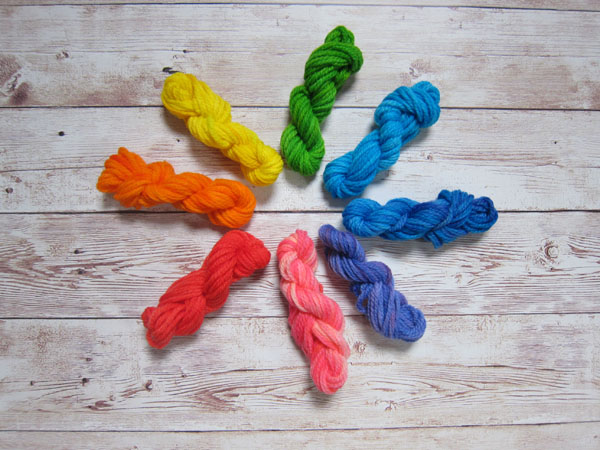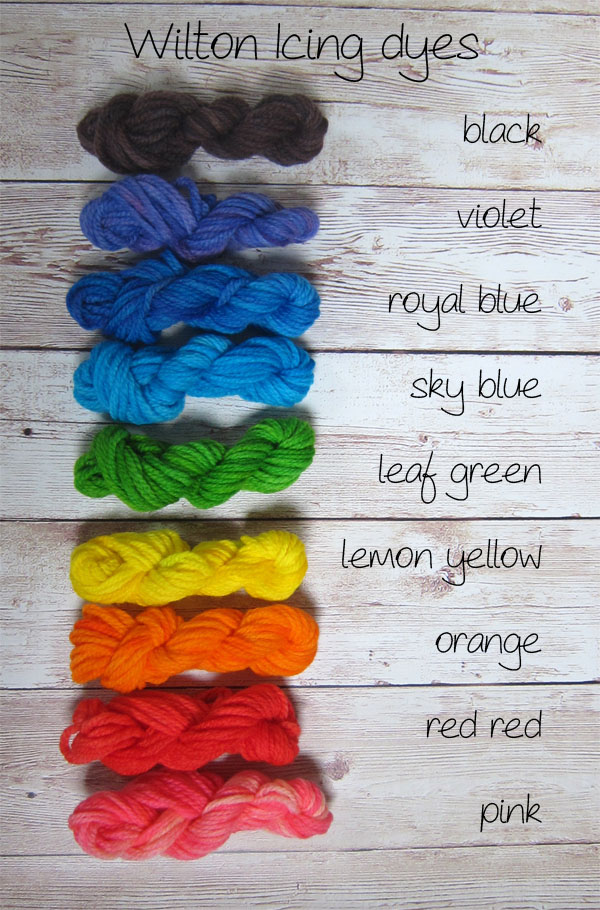Did you know that you can dye your yarn using Wilton Icing Dyes?

You already know I’m a huge fan of dyeing with Kool Aid… but the colors can be a little limiting. So I had to try my hand with the Icing Dyes!
Advantages of Icing Dye
Icing dye, as the name suggests, is actually meant for dyeing. Granted, it’s usually food and not yarn… but it means that there are a wide range of colors that are really quite nice.
The dyes also have the property that you can mix them together with fairly predictable results, which isn’t necessarily true of Kool Aid.
The main disadvantage is that you’ll need to add vinegar to your dye bath to get the color to set. That’s not too big of a downside!
Wilton Icing Dye Color Card
For each color, my recipe was:
- 8 yards of white worsted weight yarn
- 1/8 tsp of Wilton Icing Dye
- 2 T vinegar
- 1/4 cup boiling water
And here’s how the colors look!

I’m so excited about the possibilities! These are the colors straight out of the jar… you can mix the colors to get even closer to what you want.
Notes on Dyeing
- These colors were all produced with the same strength of dye. Experiment with adding less dye for more subtle colors.
- Purple is notoriously difficult. It’s hard to tell from the photo, but the blue & red tones separated out quite a bit. I love the look, but you’ll want to always test swatches if you want a certain look.
- A true black is very hard to achieve. I’ll play around with adding a higher intensity of dye.
- Always do a test swatch! These 8 yard skeins were just perfect, you can wind them yourself for playing!
Have fun!

Here are handy links to all the posts about yarn. . .
- How to Join Yarn with No Knot
- 3 Ways to Join Yarn without Tying a Knot
- What to Do If There’s a Knot in Your Yarn
- How to Work with Eyelash Yarn
- How Much Yarn Do I Need?
- How to Calculate Yarn Weight from Length
- How to Make a Magic Ball
- How to Use a Ball Winder
- Using a Nostepinne Replacement to Make a Center-Pull Yarn Ball
- How to Make Yarn from Fabric Strips
- Dye Yarn with Wilton Icing Dye
Return to the main table of contents for Let’s Learn to Crochet Amigurumi.
Move on to the lessons for the basic crochet stitches.
Happy stitching!







I have a few questions!
Does it matter what type of yarn you use? I use redheart super saver acrylic yarn. Are the results still good?
How difficult would it be to dye an entire skein?
What type of vinegar do you use?
In the photo, did you use a pink dye? How could you dilute the red to be more of a pink than red? I just wasn’t sure if they had a pink dye or if you diluted.
What if you were to soak the purple for a longer amount of time? Do you think that would help the color settle better? I’m new so forgive me. I’m on a quest of knowledge! 🙂
Hi Lexi!
You might want to search for ‘kool aid’ dyeing on my blog, as I have a lot more details about dyeing and what sorts of yarn will work. In general, only wool or other animal fibers will take the dye.
Doing a whole skein isn’t hard!
I used regular distilled vinegar, although I think any acid would work.
The photo is labeled with the exact colors I used.
I haven’t fully experimented with the purple… I’m sure there are lots of options!
I’ll also be doing some more posts, so stay tuned 🙂
I know Super Saver acrylics are nice on the pocketbook, switch to better, all wool, or better brands. I did, and it’s a pleasure to spend so much time on a project, especially knitting and dyeing and then end up with a soft, beautiful product. Red Heart just scratchy and unappealing. You’ll never go back!
Hi,
Acid dyes work on protein fibers only (wool, silk, mohair — animal hair and human hair, too). Citric acid or acetic acid (clear vinegar) are good acids to use in small amounts. There are dyes at Dharma Trading Company for synthetic fibers, such as Super Saver yarn, but i think the cost would offset savings on the yarn.
A previous commenter recommended buying wool yarn, there are inexpensive brands. Lion Brand Fisherman’s Wool dyes wonderfully — but will felt is you handle it too much.
Have fun.
Hi Stacey, I’m glad you blogged this as I saw another item regarding using Wilton Dyes before Christmas and have been searching the web for Wilton Dyes to buy. Many thanks . Hugz.
Keith x
Hello! Try adding red and green to your black to get a truer black. Not sure why this works but it does. It was something I learned long ago trying to get a better black from regular garment dyes.
Thanks! I’ll try that!
That’s because when you add complementary colours you get balck.. like red + green, violet + yellow, blue + orange. Or all 3 primary colours (red, blue and yellow) can be mixed in EQUAL proportion to get the black. Depending on the colour and amount, you will get warm or cool tone. I have not yet tried it for yarn dyeing though.
MSKAT, I am sooooo happy I came across your advise. It worked like a charm, thank you sooooo much! I was getting pretty frustrated with the purplish color, now it is a recognizable black. You rock!
Are they color fast and light fast? Is kook aid?
Yup!
Hi will the RAW UNFILTERED APPLE CIDER vinegar WORK WITH WILTON’S ?
It should work fine. It’s the acid that makes the color set.
Hi Stacey
Great blog and awesome tips! I love the options for dying with the cake dyes. I would like to know what would be a great yarn to use that I can transform into a very long like Mongolian type faux fur? Lastly I am not sure if can help or direct me I want to make a chainette style fringe again very long but not sure what yard/string I could use. I want the same movement similar to a store bought but minus the price/delivery time. Besides I have searched and can not find fringe past 6 inches or various colors. Again using your dye methods I would be able to customize my own. Thanks in advance and keep up the awesome work!
Best
Sorry – the things you’re asking about are a little more advanced than what I usually do.
Cotton is a natural fiber, would it accept the dye like wool and animal fibers?
No. Plant fibers take dye different from animal fibers and require some different materials.
Regular RIT brand fabric dye dyes cotton well with the addition of baking soda i believe. To get colors to set and be permanent, it must be hot processed. Stovetop is the best method for cotton. With cotton, the fiber is not sensitive to moist heat ot friction so no need to be cautious while stirring. Heat with stirring for about a half an hour, then remove from heat. Drain dyebath, sqeeze out excess dye and let yarn cool. Once cool begin rinsingwith cool water till water runs clear. Then rinse with warm water till it runs clear, then rinse 1 more time with the hottest water the tap can handle till it runs clear. Once the fiber is no longer discharging dye, wash once with detergent, rinse then fill a bucket or pot with water add yarn and a capful of fabric softener. Mix well for a few mins, then rinse thoroughly. Completely dry your yarn, then its ready to be rolled up into balls then knit. Dyeing cotton requires longer heating times and more intensive rinsing then animal fibers. Food coloring plus acid will also work to dye NYLON, but im not sure any knitting yarns are manufactured out of nylon. Animal fibers you have to be rather gentle with in a hot dye bath or you risk the fibers matting/felting, and you have to be careful with temperature changes for the same reason, mainly shocking hot yarns with cold water will cause matting. RIT dyes can frequently be found at discount/liquidation stores for very cheap, but if you want to see the full shade range, Michaels craft stores usually have the full line at a slightly higher price point. They also usually carry the RIT Dye More line which can be used to dye synthetic materials like acrylic yarns. The same hot dye process is used.
Teachers! Did you use this instructable in your classroom? Add a Teacher Note to share how you incorporated it into your lesson.
Thanks for telling us how you dye wool. It was interesting! Regards
hello,
i can’t figure out which colours to mix to get a subtle olive green.. i have the wilton set of 12 but am happy to buy an individual colour if needed (like juniper?)
thank you – i can’t find the ‘recipe’ anywhere.
To get the olive green color you can mix green and red. You have to be very patient adding and playing until you reach that color. Please note that Wilton also has a green moss color specifically.
Try Leaf Green and Orange. Using Red COULD work, but may turn out greyish as they are directly contrasting colours and neutralize eachother completely. Orange on the otherhand is a blend of red and yellow, so the result will still be a warm olive green, and not a flat, cold, gray-green. They yellow in orange will still keep some vibrancy to the tone, not matting it down conpletely. Or use Red and add a bit of yellow to keep the “Olive” tone lively.
Does anyone know the ratio to get a 1% dye solution from Wilton’s color right?